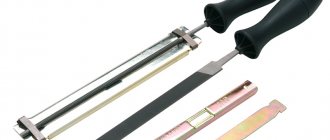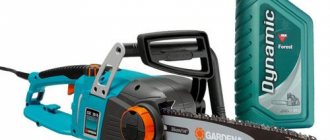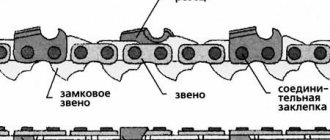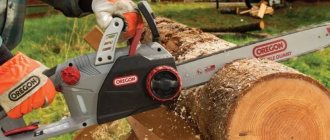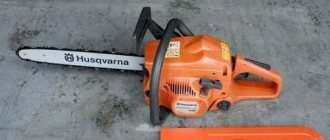Making a machine for sharpening chainsaw chains with your own hands is no more difficult than assembling a homemade grinder or band sawmill. However, such homemade products are less popular. This is probably due to their narrow specialization, as well as the presence of many alternative options using fairly simple devices that allow you to sharpen a chain with the same quality and in almost the same time. Most often, homemade machines for sharpening saw chains are designed by those who live “on the ground”, far from cities, and often use a chainsaw both for collecting firewood and for home construction.
Basic rules for sharpening
The main mistake most people make is turning with standard round files in their workshops. This operation leads to damage to the working tooth, thereby grinding down the attacking part. Here are a few rules to always remember when sharpening:
- The overall dimensions of the teeth must be the same;
- The angle of the working links and the height of the limiter must match the passport data;
- Sharpen the teeth with a specialized round file;
- The angle of attack should be equal to 90º vertically and 10-30º horizontally.
If the chain is dull and there is no way to repair it
Way out. Each of you has a grinding machine (grinder) in your household. This tool can be used for sharpening. Many categorically do not accept this method, regulating the fact that there is a possibility of damaging the chain. As they say, a strong hand and skills in working with an angle grinder will solve the problem, the main thing is not to be afraid.
But it is worth remembering that incorrect chain sharpening angles lead to increased load on the saw and reduce its performance.
I have attached a video review of this method below. Here's how to sharpen a saw chain using a grinder. In this way you can sharpen from 4 to 7 times. The chain will no longer be suitable for sharpening.
The disadvantages of sharpening this way are:
- Possibility of damaging the chain;
- Lack of tool skills can lead to injury;
- It is very difficult for a beginner to catch the sharpening angle.
When should you sharpen your saw?
The first sign that the blade needs to be checked is increased feed. A good chain fits into the wood even with just a little pressure. The second signal is a decrease in chip thickness.
Proper sharpening of a chainsaw chain with your own hands involves maintaining optimal tilt angles:
- rear corner of the top edge – responsible for cutting into the material;
- rear corner of the end blade – cuts chips from the side;
- rake angle - determines the performance of the chain.
The size of the rake angle is formed by changing the slope of the trailing edge. The efficiency of working with different materials depends on the ratio of these indicators:
Now a little theory
Elements of working chain links can be classified as follows:
- Spatula;
- Depth stop;
- Base.
The working edges are located on the tooth blades. If sharpening is carried out according to the passport data, then you can achieve good results in sawing wood. Remember, the higher the sharpening angle, the easier it will be to cut soft wood. When sawing denser or frozen lumber, the sharpening angle is reduced. This approach will, in some cases, reduce end runout and make the chain softer in operation; in other cases, you can increase the productivity of the saw - in general, there is a different approach for each wood!
Purchasing a factory machine for sharpening chains for a private individual often becomes an unprofitable investment from the economic side. That's why you have to invent and chemistry the machine yourself.
Technical parameters of chainsaw chains
It should be noted that the chain pitch directly affects the performance of the sawing tool. Therefore, to perform a large amount of work, it is recommended to choose a chain with the largest possible teeth .
Using a tool like this, the work can be done with less effort and quickly.
Technical characteristics that are important to pay attention to when choosing chains for chainsaws:
- step interval;
- number of links;
- their thickness;
- planned type and scope of work.
The smallest step is 1/4. If a chainsaw is equipped with a chain with this pitch, then it is suitable for performing simple household tasks . She will do an excellent job of cleaning fruit trees, but at the same time she will not be able to cut firewood.
Products from many European and Chinese manufacturers most often have a chain with a pitch of 0.325 and 3/8. A chain with a similar interval can cope with a wide range of work , including the removal of fairly thick trees reaching a diameter of more than two meters.
Steps 0.404 and 3/4. Chains with such an interval are usually equipped with tools for industrial use . Choosing a chain with a pitch within this range is advisable if the sawing tool is needed for frequent sawing of forest, as well as harvesting thick logs or performing tree cutting work.
As the number of links increases, the process of sawing wood becomes easier. Thus, a parameter such as the number of links also needs to be taken into account. However, a more important characteristic is their thickness, which can have the following values: 1.1 mm; 1.3 mm; 1.5 mm; 1.6 mm.
If the tool is intended for domestic use, it is recommended to choose a chain whose teeth have a thickness of 1.3 mm . If a buyer is looking for a tool for logging, it is recommended to choose a chain with a tooth size of 1.5 mm.
In cases where the chainsaw meets the tasks that need to be solved in all respects, however, there is a drop in performance, we can conclude that the reason for this is a dull chain . If poor performance is due to other problems, then the only correct solution is to buy a new chain.
What types of sharpening machines are there?
This equipment is divided into:
- Mobile;
- Stationary versions.
The stationary device is located in the workshop on a workbench or work table. The mobile machine, in turn, differs, as you may have guessed, in its overall dimensions, weight and sharpening speed. The main difference from the stationary version is that the chain will be sharpened manually using a round file. Easily suitable if you go to your summer cottage to work. Schematic diagram of mobile equipment, or you can even call this a photo or drawing - look below.
Features of choice
If a chainsaw chain fails, repairing it will be expensive. But sharpening it is often done at home. But first you need to choose the right equipment.
To do this, craftsmen take into account several parameters.
Productivity – I don’t need a powerful device to work at home. Sometimes experts use a handmade product. For industry, a more powerful option is suitable.
Dimensions – stationary devices used for chainsaw chains can be large in size; they are designed for a large number of products. You don't need such equipment for your home. In this case, the question arises where it will be stored, whether the owner has a separate room for working with wood.
Number of products processed - if the machine is not purchased for work in production, then a device that processes 1 chain at a time is sufficient.
It is additionally necessary to know what kind of chainsaw was purchased, this applies to the manufacturer. Popular manufacturers are:
- Stihl;
- Stern;
- Caliber.
First you need to look for reviews about the equipment.
We make a stationary machine
None of the machines can do without a base (bed). The old base from a bench vice can serve as a base. We drill holes in the workpiece for fastening to the workbench. Select the diameter of the holes to suit your taste.
A rotating bar with clamps is attached to the base, on which the chain will be put on and fixed when sharpening. The last element in this design, as you guessed, will be the sharpening device on the bracket.
Be sure to remember about adjusting the tilt of both the bracket and the electric drive of the sharpening device.
In our case, we use a 220 volt electric motor with a power of 85W as a drive. A grinder disc with a diameter of 125mm can serve as a working stone for sharpening. We connect a power cable with a cross section of 3*2.5mm to the engine.
At the bottom of the rotary rail we attach a scale with degrees of rotation, a reference point from 0 to 35º both left and right. If you wish, you can mount buttons to turn the drive on and off. For convenience, we mount a support handle on the engine body. It will allow you to raise and lower the drive during operation.
For full-fledged work, equip it with an LED flashlight, this will illuminate the sharpening work area and spark a protective screen from possible abrasive getting into your eyes, if you decide to work without safety glasses. So, in principle, the machine for sharpening the chain is ready. Watch the video review below.
The disadvantages of such equipment include:
- Requires 220V power supply;
- Dimensions;
- More difficult to manufacture than the mobile version.
Mobile machine
Now it's time to talk about the mobile version. The design of the mobile mechanism is similar to a bow saw. We use a specialized round file as a saw edge. Now let's talk about the details.
The base will be a plate with a fastening for a bar with clamps, on which the chain will be located. A bracket with a rotating mechanism and screws for adjustments is attached to the tire. We mount a file with a handle to this device. That's basically it. It's ready. Remember to take safety precautions when working.
Disadvantages of this device:
- Sharpening time (longer compared to a stationary machine);
- Longer sharpening time;
- If the link is severely damaged, sharpening it by hand will not be possible quickly.
If you still can’t make the machine for some technical reason, you can always use the sharpening kits that come with the chainsaw or buy a special kit in the store. Of course, this method will waste a lot of your precious time and effort.
Useful tips from professionals:
- Before work, break in the chain. It is necessary to remember that you need to run the chain at low speeds (about a minute). During this time, the sprocket and chain will warm up and the parts will rub against each other. The lubricant will perform its function. After the chain has cooled, adjust the chain tension;
- Inspect the chain. Watch the tension carefully. During the sawing process, especially when the chainsaw is tilted to one side, the chain experiences enormous stress. Due to poor tension, this leads to rupture of the connecting links. Follow safety rules when working with the tool;
- Carry out sharpening in a timely manner;
- Lubricate the saw chain regularly. Poor quality lubricant causes the chain to fly off the toe of the bar;
- It is forbidden to use mining for lubrication (although our craftsmen pour it into both Shtil and Husqvarna);
- After sharpening, it is necessary to allow the chain to cool and blow off mechanical dust with compressed air. After this, you can dip the chain in a container of clean oil. This procedure will not harm, but will only benefit. This procedure will extend the life of the product.
Share information with loved ones and friends on social networks. All the best. Good luck and see you again, Andrey Noak was with you!
Using a grinder
This method requires control over the sharpness of the teeth and the presence of certain skills. The drive sprocket must be lubricated with machine oil, and the tire must be periodically moved to the reverse position.
All manipulations are carried out directly on the chainsaw. You will need a special disk for working with metal, with a circle thickness of 2.5 mm. It is desirable that it is not new and has rounded edges.
